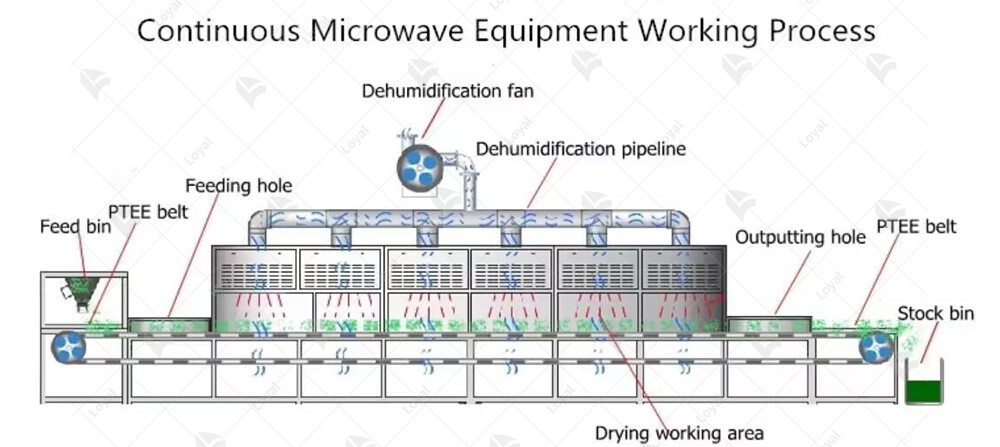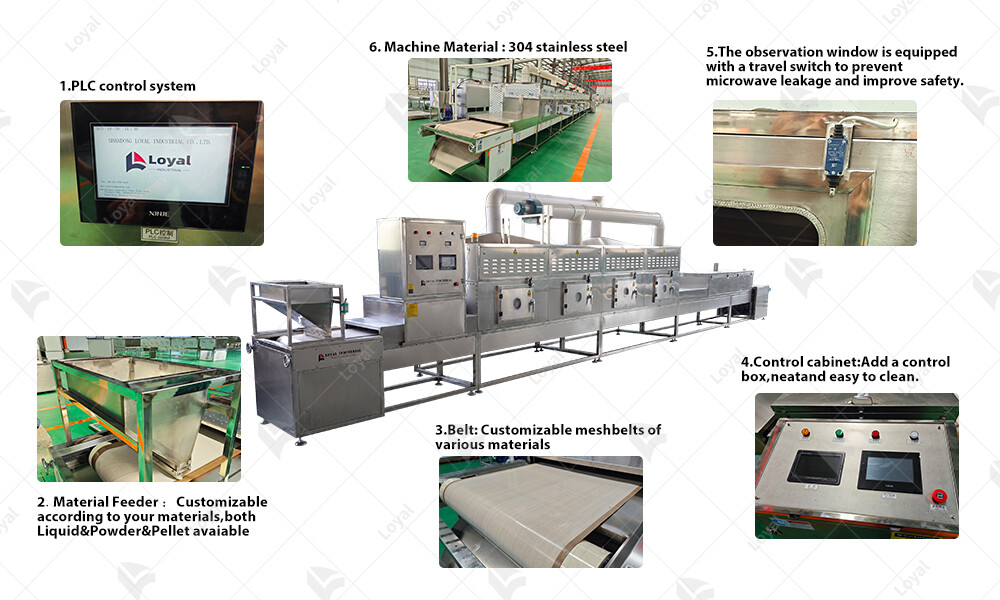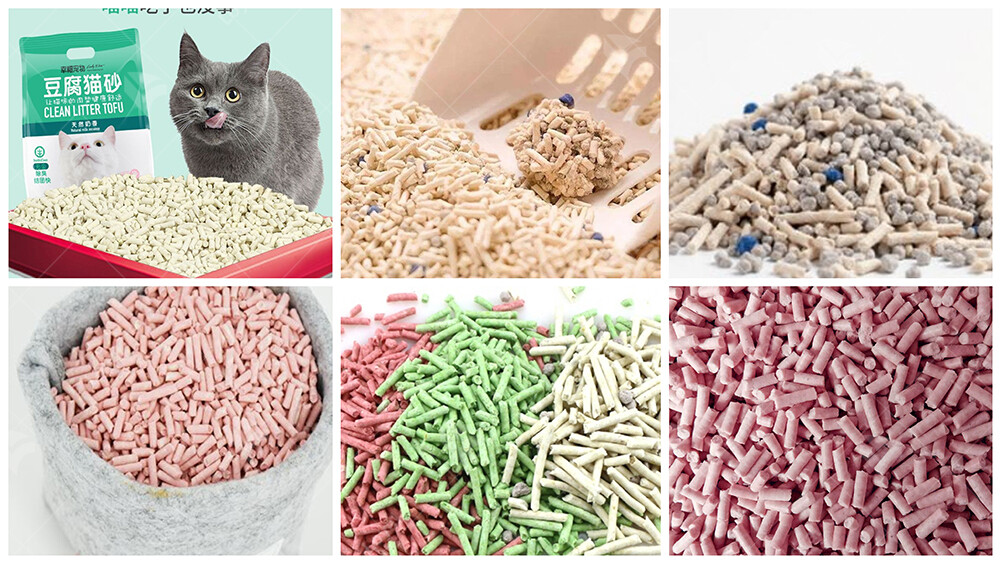The Ultimate Guide to Industrial Cat Litter Microwave Dryer Sterilization Dehydration and Drying Machine in 2024
Introduction
In 2024, the landscape of industrial cat litter management has evolved dramatically, propelled by cutting-edge technology like the Microwave Dryer Sterilization Dehydration and Drying Machine. This comprehensive guide delves into the intricacies of this innovative solution, exploring its functions, benefits, and implications for the industry.
Microwave technology has revolutionized various sectors, and the realm of cat litter processing is no exception. The Microwave Dryer Sterilization Dehydration and Drying Machine represents the pinnacle of efficiency and effectiveness in industrial-scale operations. This guide will elucidate its mechanisms, elucidate its benefits, and examine its impact on the industry in 2024 and beyond.

Working Principle
The industrial cat litter microwave dryer sterilization dehydration and drying machine operates on a sophisticated principle that amalgamates cutting-edge technology with precise engineering. At its core, this machine harnesses the power of microwave radiation to efficiently remove moisture from cat litter while simultaneously sterilizing it.
Microwave drying is a process that relies on the ability of microwaves to penetrate the material and generate heat from within. As the cat litter is exposed to microwave radiation, its water molecules begin to resonate, causing friction and subsequently heating the material. This targeted heating ensures uniform drying throughout the batch, eliminating the risk of uneven moisture content.
Moreover, the sterilization process occurs concurrently with drying, as the elevated temperatures induced by microwaves effectively eradicate pathogens and bacteria present in the cat litter. This dual-action approach not only accelerates the drying time but also ensures that the final product meets the highest standards of hygiene and quality.
Furthermore, the dehydration aspect of the machine plays a pivotal role in enhancing the overall efficiency of the process. By removing excess moisture from the cat litter, it not only prolongs its shelf life but also reduces the risk of microbial growth during storage or transportation.

Key components of microwave sterilizer
1. Magnetron:
The magnetron is the heart of the microwave sterilizer. It generates the electromagnetic waves necessary for heating the cat litter material. These waves are emitted into the cavity of the sterilizer, where they interact with the moisture molecules present in the litter, causing them to vibrate and generate heat through friction.
2. Waveguide:
The waveguide serves as a pathway for the electromagnetic waves produced by the magnetron to travel from the source to the cavity. It ensures efficient transmission of the microwave energy, minimizing loss and maximizing the effectiveness of the sterilization process.
3. Cavity:
The cavity is the chamber where the cat litter is placed for sterilization, dehydration, and drying. It is designed to withstand the high temperatures and pressures generated during the process while allowing for uniform exposure of the litter to the microwave energy.
4. Control Panel:
The control panel is the interface through which operators can monitor and adjust the various parameters of the sterilization process, such as temperature, time, and power level. It provides flexibility and precision in controlling the operation of the microwave sterilizer to achieve optimal results.
5. Cooling System:
The cooling system is essential for maintaining the temperature of the microwave sterilizer within safe limits and preventing overheating. It typically consists of fans or cooling coils that dissipate heat generated during operation, ensuring the longevity and reliability of the equipment.

Comparison and advantages of microwave technology and traditional sterilization methods
Aspect | Microwave Technology | Traditional Sterilization Methods |
Efficiency | Rapid heating and drying, reducing processing time | Longer processing time due to slower heating |
Sterilization Effectiveness | Uniform sterilization throughout the material | May have uneven sterilization, especially in bulk quantities |
Energy Consumption | Generally lower energy consumption | Higher energy consumption due to prolonged heating times |
Maintenance | Requires regular maintenance to ensure proper functioning | May require less frequent maintenance but can be more complex |
Environmental Impact | Reduced carbon footprint due to shorter processing times | May contribute to higher emissions due to longer processing |
Cost | Initial investment may be higher, but operational costs are generally lower | Lower initial investment, but higher operational costs over time due to energy consumption |

Types of microwave sterilizers
In 2024, industrial cat litter microwave dryer sterilization dehydration and drying machines have evolved significantly, particularly in the domain of sterilization. Among the types of microwave sterilizers available, several stand out for their efficiency and effectiveness.
1. Batch Microwave Sterilizers: These sterilizers are designed for smaller-scale operations, offering versatility and ease of use. Batch microwave sterilizers utilize controlled microwave energy to effectively eradicate pathogens and microbes from cat litter, ensuring a hygienic product ready for further processing.
2. Continuous Microwave Sterilization Systems: Ideal for larger industrial settings, continuous microwave sterilization systems offer high throughput and consistent performance. These systems employ a continuous conveyor belt or other mechanisms to facilitate the uninterrupted flow of cat litter through the sterilization chamber. This ensures thorough and uniform sterilization while maximizing efficiency and productivity.
3. Vacuum Microwave Sterilizers: Vacuum microwave sterilizers are engineered to create a vacuum environment within the sterilization chamber, enhancing the penetration of microwave energy into the cat litter material. This results in more thorough sterilization, even in dense or compacted litter substrates. Additionally, vacuum conditions help preserve the nutritional and sensory qualities of the cat litter.
4. Hybrid Microwave Sterilization Systems: Combining microwave technology with other sterilization methods such as hot air convection or infrared radiation, hybrid microwave sterilization systems offer enhanced flexibility and efficacy. These systems can tailor the sterilization process to suit specific cat litter compositions and processing requirements, ensuring optimal results while minimizing energy consumption and processing time.

Technical parameters
| Technical Parameters Of Continuous Microwave Dryer Industrial Microwave Drying Machine | |||||
| Model | Size LWH(Can be customized according to the customer's requirements) | Output power | Dewaterability | Sterilization capacity | Baking and Roasting capacity (Depends on different raw material) |
| LY-10KW | 5000mm825mm1750mm | ≥10KW | 10KG/Hour | 100KG/Hour | 30-50KG/Hour |
| LY-20KW | 8000mm825mm1750mm | ≥20KW | 20KG/Hour | 200KG/Hour | 60-100KG/Hour |
| LY-30KW | 8500mm1160mm1750mm | ≥30KW | 30KG/Hour | 300KG/Hour | 90-150 KG/Hour |
| LY-40KW | 10000mm1160mm1750mm | ≥40KW | 40KG/Hour | 40KG/Hour | 120-200KG/Hour |
| LY-50KW | 12500mm1160mm1750mm | ≥50KW | 50KG/Hour | 500KG/Hour | 150-250KG/Hour |
| LY-60KW | 13500mm1450mm1750mm | ≥60KW | 60KG/Hour | 600KG/Hour | 180-300KG/Hour |
| LY-70KW | 13500mm1500mm1750mm | ≥70KW | 70KG/Hour | 700KG/Hour | 210-350KG/Hour |
| LY-80KW | 13500mm1650mm1750mm | ≥80KW | 80KG/Hour | 800KG/Hour | 240-400KG/Hour |
| LY-100KW | 16800mm1650mm1750mm | ≥100KW | 100KG/Hour | 1000KG/Hour | 300-500KG/Hour |
| LY-150KW | 22400mm1850mm1750mm | ≥150KW | 150KG/Hour | 1500KG/Hour | 450-750KG/Hour |
| LY-200KW | 27000mm1850mm1750mm | ≥250KW | 250KG/Hour | 2500KG/Hour | 750-1250/Hour |
| LY-300KW | 32000mm1850mm1750mm | ≥300KW | 300KG/Hour | 3000KG/Hour | 900-1500KG/Hour |
| Power Supply | 380V±10% 50Hz±1% Three-Phase Five-Wire | ||||
| Microwave Output Frequency | 2450±50Mhz | ||||
| Microwave Input Apparent Power | ≤168Kva | ||||
| Microwave Output Power | ≥120Kw | ||||
| Microwave Power Adjustment Range | 0-30Kw(Adjustable) | ||||
| Ambient Temperature | -5-40°C | ||||
| Relative Humidity | ≤80%, Surrounding Environment:No Corrosive Gas, Conductive Dust And Explosive Gas | ||||
| Transmission Speed | 0-10m/Min(Adjustable) | ||||

Application
Industrial cat litter microwave dryer sterilization dehydration and drying machines have revolutionized the process of preparing cat litter for market distribution.
Utilizing advanced microwave technology, these machines offer unparalleled efficiency and effectiveness in sterilizing, dehydrating, and drying cat litter to meet the highest standards of quality and safety.
With precise control over temperature and moisture levels, industrial cat litter microwave dryer sterilization dehydration and drying machines ensure that the final product is free from harmful pathogens and contaminants, providing peace of mind to both manufacturers and consumers alike.
In 2024, these machines stand as the pinnacle of innovation in the pet care industry, offering a reliable solution for producing premium-quality cat litter on a large scale.

Technological progress and innovation of microwave sterilizers
In 2024, technological progress and innovation have ushered in a new era for industrial cat litter processing with the advent of the Microwave Dryer Sterilization Dehydration and Drying Machine. This cutting-edge equipment represents a paradigm shift in the way cat litter is treated, offering unparalleled efficiency and effectiveness.
Microwave technology has long been recognized for its ability to rapidly and evenly heat materials, making it an ideal choice for the drying and sterilization processes inherent in cat litter production. The Industrial Cat Litter Microwave Dryer utilizes this technology to achieve superior results in a fraction of the time compared to conventional methods.
Sterilization is a critical step in cat litter production, ensuring the elimination of harmful bacteria and pathogens that can pose health risks to both pets and their owners. With the Industrial Cat Litter Microwave Dryer, sterilization is achieved quickly and effectively, thanks to the penetrating power of microwave energy. This not only ensures the safety of the end product but also extends its shelf life, reducing waste and maximizing profitability for manufacturers.
Dehydration is another key aspect of cat litter processing, as it removes excess moisture from the material, preventing clumping and ensuring optimal performance. The Industrial Cat Litter Microwave Dryer excels in this regard, utilizing precise control mechanisms to achieve the perfect level of dehydration without compromising the integrity of the litter.
Furthermore, the drying process is essential for enhancing the absorbency of cat litter, ensuring that it effectively captures and neutralizes odors. The Industrial Cat Litter Microwave Dryer leverages advanced drying techniques to achieve consistent results, producing a high-quality product that meets the needs of both pets and their owners.
In conclusion, the Industrial Cat Litter Microwave Dryer Sterilization Dehydration and Drying Machine represents the pinnacle of innovation in cat litter processing. Its combination of cutting-edge technology, efficiency, and effectiveness makes it the ultimate choice for manufacturers looking to optimize their production processes in 2024 and beyond.

Precautions for Selecting and Implementing Microwave Sterilizers
Microwave sterilization technology has gained considerable traction in various industries, including the cat litter manufacturing sector. In this guide, we will discuss essential precautions to consider when selecting and implementing industrial microwave sterilizers for cat litter production.
1. Understand the Specific Requirements:
Before investing in a microwave sterilization system, it's crucial to understand the unique requirements of the cat litter manufacturing process. Consider factors such as the volume of cat litter produced, the desired level of sterilization, and the moisture content of the material.
2. Evaluate Equipment Compatibility:
Not all microwave sterilizers are created equal. Ensure that the selected equipment is compatible with the characteristics of the cat litter material. Look for features such as adjustable power settings, precise temperature control, and uniform heating capabilities to achieve optimal results.
3. Prioritize Safety Features:
Safety should be a top priority when selecting a microwave sterilization system. Choose equipment that is equipped with advanced safety features such as automated temperature monitoring, overheat protection, and emergency shutdown mechanisms to mitigate the risk of accidents or equipment malfunctions.
4. Consider Efficiency and Productivity:
Investing in a high-efficiency microwave sterilization system can significantly impact productivity and operational costs. Look for features such as rapid heating capabilities, continuous processing options, and energy-efficient designs to streamline the sterilization process and maximize throughput.
5. Ensure Compliance with Regulations:
Cat litter products are subject to various regulatory standards and guidelines, particularly regarding microbial contamination levels. Select a microwave sterilization system that complies with relevant industry regulations and standards to ensure the production of safe and hygienic cat litter products.
6. Implement Proper Training and Maintenance Protocols:
Proper training and maintenance are essential for the successful implementation of microwave sterilization systems. Ensure that operators receive comprehensive training on equipment operation, maintenance procedures, and safety protocols to optimize performance and prolong equipment lifespan.
7. Monitor Performance and Quality:
Regular monitoring of sterilization performance and product quality is crucial for identifying potential issues and ensuring consistency in product output. Implement robust quality control measures, such as microbial testing and product sampling, to verify the effectiveness of the sterilization process.

Post-Maintenance of Microwave Sterilizer
After the rigorous sterilization processes facilitated by the Industrial Cat Litter Microwave Dryer Sterilization Dehydration and Drying Machine, proper post-maintenance is imperative to sustain its functionality. Here's a concise yet comprehensive outline of essential steps:
1. Cleaning and Sanitization:
Following each sterilization cycle, meticulously clean the interior and exterior of the microwave chamber using approved sanitizers. Remove any residual cat litter particles or debris to prevent contamination in subsequent cycles. Regular sanitization not only ensures hygienic standards but also prolongs the lifespan of the equipment.
2. Inspection of Components:
Conduct routine inspections of crucial components such as the magnetron, waveguide, and control panel. Any signs of wear, corrosion, or malfunction should be addressed promptly to avoid operational disruptions. Regular maintenance checks contribute to uninterrupted productivity and mitigate the risk of unexpected breakdowns.
3. Calibration and Testing:
Periodically calibrate the microwave sterilizer to verify its accuracy in delivering the desired sterilization parameters. Utilize calibrated test equipment to validate the effectiveness of the drying and sterilization processes. Accurate calibration ensures consistent performance and adherence to quality standards, vital for industries reliant on precise sterilization protocols.
4. Upgradation of Software and Firmware:
Stay abreast of technological advancements by regularly updating the software and firmware of the microwave sterilizer. Manufacturers often release firmware updates to enhance efficiency, address potential vulnerabilities, and introduce new features. Timely upgrades optimize the functionality of the equipment, ensuring compatibility with evolving industry standards.

References
The following are five authoritative foreign literature websites in the field of industrial microwaves:
1. IEEE Xplore Digital Library
Website: [https://ieeexplore.ieee.org/]
2.ScienceDirect
Website: [https://www.sciencedirect.com/]
3. SpringerLink
Website: [https://link.springer.com/]
4. Wiley Online Library
Website: [https://onlinelibrary.wiley.com/]
5. PubMed
Website: [https://pubmed.ncbi.nlm.nih.gov/]
 Telephone :+86-531-55583139
Telephone :+86-531-55583139 WhatsApp :+86 13256674591
WhatsApp :+86 13256674591 Email :
Email :










